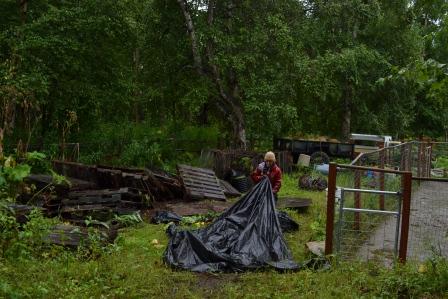
Home > Trip > Dispatches > Daily Dispatches > Daily Dispatch #255
August 20, 2012: Compost Continues to Happen
It rained all night. It stopped briefly this morning. I hustled out of the house and tended to the horses, chickens, and goats, all of whom were dry. The scenario here is now reminiscent of Noah’s Ark, except for the fact that the ark is a 2.5 acre parcel of land. Anyhow, I’m taking great satisfaction in noting that all the animals are dry and well fed. I began work on the new compost facility last night. I dismantled all but two of the old stations in the lower quadrants and put the old pallets and whatnot in piles. The whatnot consisted of plastic garbage cans, rotting particle board covers. Perfect slug growing territory. This turned out to be |
|
| yet another time consuming undertaking—it took me all evening. Later today, I’ll first move the bucketed manure, then sort through the piles, keeping the best pallets, and taking the rest (along with the whatnot) to the dump. I’ll then move the contents of the one full compost station, piling it up and covering it over. I had planned on turning it and sifting it, but instead decided to put my limited energies into getting the facility going. I’ll first clear the old site, and then begin constructing the new site. I’ll dig four holes and put in posts for the shed. Pete suggested that we (I love that word, we) use railroad ties for the foundation of the back wall – this will then mean that I’ll have four less holes to dig. I’ll then consult with Pete on the next phase of the project. I’ve never before done anything like this. Pete is the resident builder. I can’t expect him to do this project because he’s already done so much around here. So, I, who have a vision, am going to take this one on. Thinking about this project in its entirety is daunting. But taking it one step at a time is less overwhelming. It’s definitely an instance of one step backwards, and two steps forward. The step backwards: I felt bad about dismantling the old facility because it was so well constructed. We’d lined the pallets with chicken wire, and tied them in place with baling twine. It seemed a shame to have to take it apart. I also felt as though I‘d become a card carrying member of the sloth and indolence party. There was a time when I had 16 compost stations all going at once. But back then, I had two horses and no goats. Now of course, I have five horses and three goats, all of whom are clamoring for attention. Plus, we now have an untold amount of garden waste. The two steps forward: I see this facility as being a model for others in our situation, which are those who have more manure than they can turn by hand. Manure disposal is a weak link for many horse owners, so this will give them some ideas as to how to strengthen their link. The facility will be enclosed in a shed with plastic covering, and the now larger stations will be commodious, having enough room for greens, coffee grounds, worm castings, and the like. The beauty of this is that manure decomposes, making for less overall bulk. I plan on selling some of the compost, and giving the rest away. I’d also like to set aside space for my worm farm and mushroom growing facility. My original plan (which was to sell hand sifted/hand turned compost) has sort of gone by the wayside. I sifted seven buckets worth, and suspect that we’ll put it to use in our own garden. The problem with hand turning/sifting is that it’s time consuming. Plus, we now reside in a coastal climate, which makes for soggy compost. Having a shed will enable me to keep the manure/compost dry. And turning it with a tractor will make the process less labor intensive. (A neighbor is going to lend us his machine.) There are some who might say that the use of a tractor defeats our purpose, which seemed to be to break free of our reliance upon gas powered machinery. My counter argument is that clinging to this belief would be hard on my back. Instead, we’ll be making copious amounts of garden soil—and at the same time showing others how it might be done. I hope to complete this project by the time the snow flies. This way, we’ll have a storage area for the upcoming winter manure. |
|
